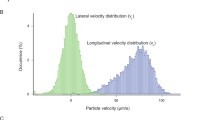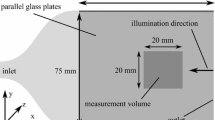Abstract
Quantitative in-plane velocity measurement by means of particle image velocimetry (PIV) within thin-gap devices subject to a large depth of focus and Poiseuille flow conditions across the gap is investigated. The primary obstacles to a reliable quantitative measurement are due to the effects of the inherent wall-normal velocity gradient and the inertial migration of particles in the wall-normal direction. Specifically, in the simplest case of no particle migration, the PIV correlation peak is broadened due to velocity variations within the interrogation region, and the result is expected to predict the maximum centerline velocity. The current work demonstrates, however, that there is an inevitable underestimation of the peak velocity due to the convolution of the fluid displacement probability distribution function (PDF) by the particle image size that introduces a biased error typically up to 33 % of the centerline velocity for all but the smallest particle images and largest displacements. Due to the low signal-to-noise ratio caused by the velocity gradient, the probability of a valid estimate is significantly impaired, demanding an unrealistically high concentration of tracer particles. In addition, inertial particle migration within the channel introduces a selective sampling of the velocity PDF, causing a second correlation peak to emerge as the particles rapidly move away from the wall, making a reliable measurement troublesome. In later times, the particles reach their equilibrium position and hence sample only a single velocity value, presenting conditions similar to traditional PIV interrogations, with the correlation function reduced to a single symmetric peak. A practical procedure is proposed to make PIV quantitative by manipulating the particles to their equilibrium position prior to performing measurements. A demonstration of a reliable PIV measurement under appropriate working conditions is discussed for diffusive Rayleigh–Bénard convection in a Hele-Shaw cell.










Similar content being viewed by others
References
Adrian RJ, Westerweel J (2010) Particle image velocimetry. Cambridge University Press, London
Asmolov ES (1999) The inertial lift on a spherical particle in a plane Poiseuille flow at large channel Reynolds number. J Fluid Mech 381:63–87
Backhaus S, Turitsyn K, Ecke RE (2011) Convective instability and mass transport of diffusion layers in a Hele-Shaw geometry. Phys Rev Let 106(10):104501:1–4
Cierpka C, Kahler CJ (2012) Particle imaging techniques for volumetric three-component (3D3C) velocity. J Vis 15:1–31
Fernandez J, Kurowski P, Petitjeans P, Meiburg E (2002) Density-driven unstable flows of miscible fluids in a Hele-Shaw cell. J Fluid Mech 451:239–260
Fouras A, Dusting J, Lewis R and Hourigan K (2007) Three-dimensional synchrotron x-ray particle image velocimetry. J Appl. Phys.102:064916
Ho B, Leal L (1974) Inertial migration of rigid spheres in two-dimensional unidirectional flows. J Fluid Mech 65:365–400
Keane RD, Adrian RJ (1992) Theory of cross-correlation analysis of PIV images. Appl Sci Res 49:191–215
Kloosterman A, Poelma C, Westerweel J (2011) Flow rate estimation in large depth-of-field micro-PIV. Exp Fluids 50:1587–1599
Matas JP, Glezer V, Guazzelli E, Morris JF (2004) Trains of particles in finite-Reynolds-number pipe flow. Phys Fluids 16:4192–4195
Meinhart C, Wereley S, Santiago J (1999) PIV measurements of a microchannel flow. Exp Fluids 27:414–419
Meinhart CD, Wereley ST, Santiago JG (2000) A PIV algorithm for estimating time-averaged velocity fields. J Fluids Eng 122:285–289
Mielnik MM, Saetran LR (2006) Selective seeding for micro-PIV. Exp Fluids 41:155–159
Neufeld JA, Hesse MA, Riaz A, Hallworth MA, Tchelepi HA, Huppert HE (2010) Convective dissolution of carbon dioxide in saline aquifers. Geophys Res Let 37:L22404
Nguyen CV, Carberry J, Fouras A (2011) Volumetric-correlation PIV to measure particle concentration and velocity of microflows. Exp Fluids 52:663–677
Olsen MG, Adrian RJ (2000) Out-of-focus effects on particle image visibility and correlation in microscopic particle image velocimetry. Exp Fluids (Suppl.) S166–S174
Riaz A, Hesse M, Tchelepi HA, Orr FM (2006) Onset of convection in a gravitationally unstable diffusive boundary layer in porous media. J Fluid Mech 548:87–111
Rossi M, Segura R, Cierpka C, Kähler CJ (2012) On the effect of particle image intensity and image preprocessing on the depth of correlation in micro-PIV. Exp Fluids 52:1063–1075
Roudet M, Billet A-M, Risso F, Roig V (2011) PIV with volume lighting in a narrow cell: an efficient method to measure large velocity fields of rapidly varying flows. Exp Them Fluid Sci 35:1030–1037
Segré G, Silberberg A (1962) Behaviour of macroscopic rigid spheres in Poiseuille flow: part 2. Experimental results and interpretation. J Fluid Mech 14:136–157
Wereley ST, Whitacre I (2007) Particle dynamics in a dielectrophoretic microdevice. BioMEMS and biomedical nanotechnology (series ed. M. Ferrari): vol 4: biomolecular sensing, processing and analysis (vol. eds R. Bashir and S.T. Wereley). Kluwer, Boston
Westerweel J (2000) Theoretical analysis of the measurement precision in particle image velocimetry. Exp Fluids 29:S3–S12
Westerweel J (2008) On velocity gradients in PIV interrogation. Exp Fluids 44:831–842
Wieneke B, Pfeiffer K (2010) Adaptive PIV with variable interrogation window size and shape. In: 15th International symposium applies laser technical fluids mechanics, Lisbon, Portugal, July 5–8
Author information
Authors and Affiliations
Corresponding author
Rights and permissions
About this article
Cite this article
Ehyaei, D., Kiger, K.T. Quantitative velocity measurement in thin-gap Poiseuille flows. Exp Fluids 55, 1706 (2014). https://doi.org/10.1007/s00348-014-1706-8
Received:
Revised:
Accepted:
Published:
DOI: https://doi.org/10.1007/s00348-014-1706-8




